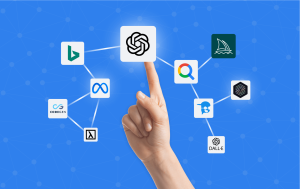Introduction
Open your phone, ask for today’s biggest story, and you now get more than a list of blue links. A short, machine-written summary appears first, pulling highlights from many outlets at once.
These AI overviews are changing the very start of every news journey. They speed up fact-finding, sift through noise, and point to deeper reads.
Yet they also raise new questions: How are these mini reports built? Can we trust them? And what should journalists do to stay visible? This simple guide answers those questions in clear language, showing why 2025 marks a turning point in news search AI.
What Is an AI Overview
Quick Definition
An AI overview is a short, auto-generated recap that sits above regular results in modern search engines. It combines AI search summaries with links to sources so readers see key points before diving deeper.
How It Works Behind the Scenes
The engine first detects that a query, like “wildfire in California,” needs a current, fact-based answer. It then pulls fresh articles, applies natural-language models, filters out opinion, and stitches a neutral digest. A relevance score ranks sentences, while a confidence score decides if the overview should even show. Finally, it cites headlines so users can trace facts.
History and Growth
Traditional search engines list links to news articles. In the early 2020s, news aggregators improved that by grouping similar stories.
By 2025, AI overviews evolved further. Advances in natural language processing (NLP) let AI understand human language, identify facts, and generate concise, coherent summaries. Major news platforms and apps now use AI to show overviews alongside headlines. This shift helps everyone from busy professionals to casual readers get news quickly.
Why Search Engines Added AI Overviews in 2025

Natural Language Processing (NLP) Techniques
Once data is collected, NLP algorithms analyze text to find key sentences. The AI identifies topic words, named entities (like people, places, organizations), and verbs showing actions. It uses models trained on large news corpora to learn how to spot facts and separate them from opinions. The AI also checks for overlapping information across multiple sources, so overviews don’t repeat the same point.
Rising Information Overload
Global news output doubled in five years. Users scrolling endless headlines felt lost. AI overviews trim that load into one clear paragraph, easing cognitive strain.
User Demand for Context
Readers no longer want single facts. They want background, impact, and next steps. Summaries give quick context while offering pathways for deeper dives.
Summarization Methods
There are two main summarization approaches. Extractive summarization picks out existing sentences from articles that capture core ideas. Abstractive summarization rewrites information in new words, making a more natural, cohesive overview.
In 2025, many AI overviews use a blend: they extract key facts and then paraphrase them to form clear, readable summaries. This hybrid method balances accuracy and readability.
Fact Checking and Verification
AI overviews need reliable facts. Some systems cross-check details against trusted databases or official sources.
If two or more reputable outlets report the same number or claim, the AI flags it as verified. When sources conflict, AI overviews note discrepancies, warning readers of uncertainty. This step helps maintain accuracy and reduce the spread of rumors or false information.
Personalization Layers
Modern AI overviews adapt to individual interests. By analyzing your reading habits and search history, AI can prioritize certain topics, regions, or outlets. For example, if you often read about climate change, your news app’s AI overview will highlight related stories. Personalization boosts engagement and ensures you see news that matters most to you.
Impact on How We Search and Read News
Faster Fact Checks
Journalists once opened ten tabs to confirm a statement. Now a single overview compares multiple outlets, cutting verification time in half.
Discovering Diverse Sources
Because the model scans a wide pool, it often surfaces local or niche voices that an earlier algorithm might bury. This widens public conversation.
Risks of Misinformation
AI can misjudge sarcasm, outdated statistics, or paywalled content. A shaky summary spreads fast if readers accept it without clicking through. Careful model tuning and human oversight remain vital.
Examples of AI Overview Applications

News Aggregator Platforms
Several popular news aggregators now show AI overviews along with headlines. When you scroll through your feed, each headline has a short paragraph summarizing the story from various sources. Users can tap “Read More” to see full articles or verticals of related pieces. This feature transforms a long list of links into a digestible, curated experience.
Voice-Activated Assistants
Voice assistants like smart speakers and smartphones now integrate AI overviews for news queries. If you ask, “What happened in the tech world today?” the assistant quickly summarizes key events, such as product launches or mergers. This hands-free, auditory delivery is ideal during busy routines or commutes.
Social Media Integration
Social media platforms are testing AI overviews for news posts. Instead of just showing a link and a few lines, posts include an AI summary beneath the headline. Viewers can get the gist directly in their feed. This feature helps prevent misinformation, as AI highlights verified details and flags unconfirmed claims.
Benefits and Challenges: At a Glance
| Area | Benefits | Challenges |
|---|---|---|
| Readers | Saves time, offers broad view | May flatten nuance, risk errors |
| Publishers | Extra exposure for quality work | Harder to earn clicks if summary satisfies |
| Advertisers | More relevant ad context | Less space for display ads |
| Search Engines | Higher user trust and retention | Greater legal duty for accuracy |
Tips for Readers to Get the Most From AI Overviews
Compare Multiple Summaries
Ask the same question in different words. Subtle wording shifts can bring fresh angles or reveal gaps.
Check Timestamp and Source List
Always note when the overview pulled its data. A two-hour gap during a breaking event matters. Skim the cited outlets to judge balance.
Customize Settings
Most engines let you favor local news, global coverage, or certain topics. Adjust filters so future digests match your needs.
Advice for News Publishers
Focus on Expertise and Original Data
Engines rank sources by depth and uniqueness. Field reports, verified datasets, and expert quotes rise above rewrites.
Use Structured Metadata
Clear author lines, publication dates, and schema tags help crawlers identify trustworthy material, boosting visibility in the new AI-driven news discovery era.
The Future of News Search After AI Overviews

Personalized Streams
Next-gen models will learn each reader’s trusted outlets and tone preferences, shaping personalized news summaries that feel tailor-made while still diverse.
Voice and Multimodal Queries
Smart speakers already answer follow-up questions conversationally. Soon you might ask for a map of affected regions or a chart of poll numbers, and the overview will blend text with visuals.
Table: Comparing AI Overviews and Traditional Search Results
| Feature | AI Overviews | Traditional Search Results |
|---|---|---|
| Time to Understand | Seconds (short summaries) | Minutes (read full articles) |
| Information Sources | Multiple sources condensed | Single-source links |
| Redundancy Reduction | High (combines repeated details) | Low (repetitive content across links) |
| Personalization | AI tailors summaries to user interests | User manually selects articles |
| Accessibility | Simplified language, audio available | Dependent on article readability |
| Context and Background | Frequently included in overview | Readers must search multiple articles for context |
| Bias and Verification | Highlights consensus and conflicts | Readers must compare sources independently |
| Offline Usage | Some apps cache summaries for offline reading | Limited, depends on cached pages |
| Ideal Use Case | Quick news updates, broad overviews | Deep research, detailed analysis |
| Learning Curve | Low (easy to read) | Moderate (may require topic familiarity) |
Conclusion
AI overviews move the first click of news discovery from a long list of links to a concise snapshot of the story. They help readers grasp facts fast, aid publishers who provide depth, and push search engines to new levels of responsibility.
As models improve and guidance tightens, the key will be balance: speed without loss of nuance, breadth without loss of trust. If both users and creators stay alert—checking sources, adding context, refining metadata—AI overviews can become a bridge to reliable information rather than a gate that hides it.
Call to Action
Try an AI overview today: type a current headline into your favorite search engine and study the summary. Then click through to at least two original articles for full detail. Share what you learn with friends, and urge your local newsrooms to adopt clear metadata so their work shines in this new landscape. By taking these small steps, you shape a faster yet richer future for news search.











